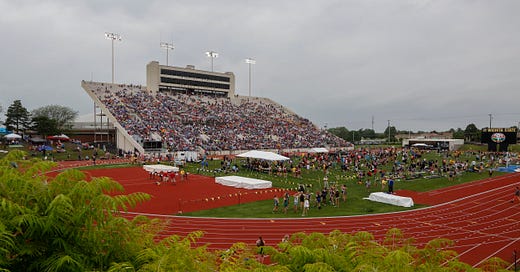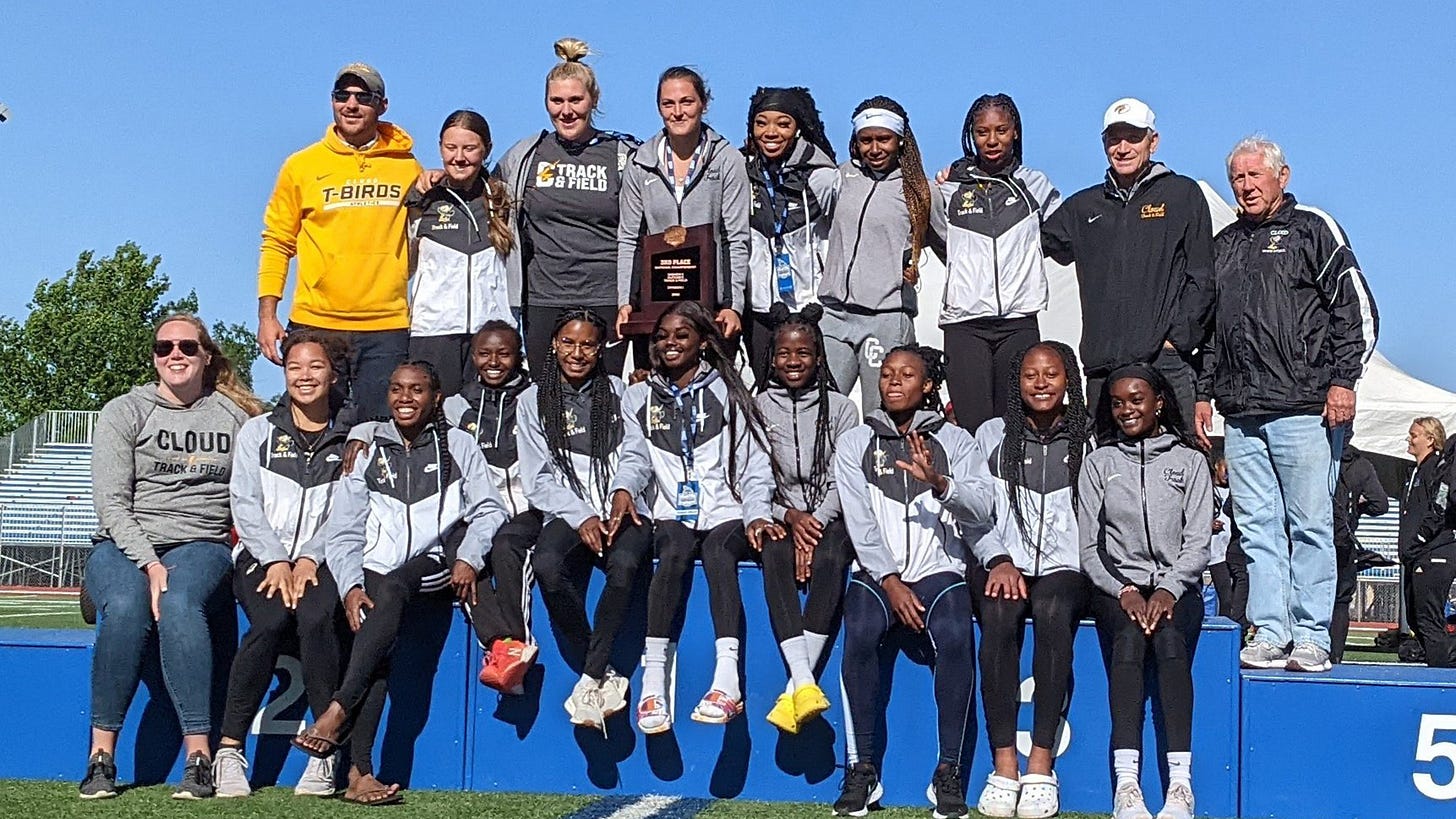Kansas regionals are simply broken🩹
Over the weekend I was in Colorado celebrating my college graduation, but it seems I picked the most controversial weekend of the season to be out of town. Year after year, regionals come and go and there is always something that needs changing. The average spectator might just say, “Why don’t you advocate for a new system?” Well that’s just it, it seems that coaches and schools have tried to do that during the off-season, but have seen very few results, if any at all. Keep in mind, none of this is written to take away from those who qualified for state, their coaches, or anyone in the sport. I decided to write about this because I felt it was too hot of topic in the Kansas track and field community to not talk about. With that out of the way, here we go.
From what I could find, Kansas is one of the only states that still use our current qualifying method, leading me to believe that as a state, we are far behind a lot of others. For those of you that are just tuning in, here’s a brief explanation of how the current qualification method works.
For each of the six classifications in Kansas, there are four separate regionals that are split up based off of location. For example, Class 6A had four regional meets, hosted by Olathe North, Shawnee Mission South, Topeka High, and Wichita Northwest. Each team in the meet is allowed to enter three athletes per event, and I believe there are no exceptions. For each event, the top four finishers qualify for the state meet a week later. Technically, that means that every event at state should four entries from each region, and sixteen total. At first glance you may not see any major flaws or faults in the system, but there are a few.
This last week I saw a tweet from a coach about how they had more than three javelin throwers that could have competed for a medal at state. With the current rules, they were only allowed enter their top three into the regional, leaving their other skilled throwers to watch the meet from home. These athletes had better marks than other athletes from other regions, who had the opportunity to qualify for state.
Even though there are a few things wrong with the system, there is one fault that came to the forefront after this past weekend.
Disclaimer: The rankings I have are post-regionals, but I think my point still stands. Here we go.
Regional 1 had the 1st, 3rd, 5th, 6th, 7th, 12th, 18th, and 21st best marks in the class this year in this particular event event, while Regional 2 had the 17th, 20th, 23rd, 24th, and 27th respectively. Purely based on the data, Regional 1 had five of the top eight marks in the class, all in the position to medal. At the regional meet, the 1st, 3rd, 5th and 6th ranked teams finished in the top four, leaving the 7th ranked mark out of the qualifiers. At Regional 2, there were only two total entries in the event. Clearly, only two teams started and finished the race, meaning only two schools from this region qualified for state. The question that remains is what do we do about the two remaining spots?
I’ve seen a lot of different ideas on how to solve this issue, but due to a quick turnaround and little time in between state and regionals, the event will only see fourteen entries instead of sixteen at state. One possibility is to simply send the next two fastest teams from the regional weekend and call it good, right? That would mean that the 7th and 16th ranked team in the class would both get to compete at the state meet by taking the final two spots. In the long run, it seems a new regional/qualifying format could possibly be introduced to avoid this problem in years to come, and hopefully that is what ends up happening.
Long-term options are a dime a dozen, but the real question is which one of them is the best for the athletes? A popular idea I’ve seen around is a mixture of automatic qualifiers from regions and then filling the rest of the field with at-large bids based off of state rankings. There are multiple ways you could structure this method by adjusting the number of automatic and at-large bids. You could have two automatic qualifiers from each of the four regions, and then fill the remaining eight spots with the next eight best performances from regional weekend. You could even make it three qualifiers per region and four at-large, either could work. I personally think that this method would be the best for the athletes, but then again, I don’t have any say in the matter. Anyway, there are some other ideas that I saw being tossed around on a great Twitter thread that I suggest you check out if you’re interested.
What if we just expanded the state field to eighteen or twenty? What if we followed in the footsteps of Maryland and use a “yearly time standard based on the scoring performance in an event from the previous season” and switch things up? I’m honestly not sure if these issues are even being acknowledged or addressed by certain people, but I sure hope so.
Honestly, I’m not personally upset that there are two open spots at state this weekend. I’m frustrated that this could have been prevented and even solved.
Overall, I believe that the current system is flawed and has opened the door for possible adjustments, improvements, or even an entirely new format in general. At the end of the day, whether we are feel the need for a new format or not, I believe that we all want the same thing. We want each and every athlete to have a fair and equal opportunity to punch their ticket to Cessna Stadium every year at the end of May. I can confidently say that we all agree on that, and I hope that there is something done to address the issue. Thanks for coming to my TED Talk.
Cooper Schroeder on the move🚛
On a much more positive note, the Kansas State star and former Manhattan state champion is taking his talents to Tallahassee, FL. Before he became a Wildcat, the youngest Schroeder sibling built up quite the résumé while wearing the navy and red. He collected a lone state title in the 3200m in 2018, along with five additional All-State finishes on the grass and the track. Just as we expected, Schroeder made a splash as a Wildcat, setting school records in the 8k (XC) and the indoor 5k. He also earned All-Big 12 honors three separate times (20’ XC, 21’ indoor 5k, 21’ outdoor 10k). I meant to ask Schroeder how much eligibility he has left, but I am fairly confident it is more than one full year. It’ll be weird seeing him in maroon and gold, but the sky is the limit for the Manhattan native and I think he’s capable of great things coming up.
JUCO Recap📖
Last weekend, the NJCAA DI Outdoor Track & Field Championships were hosted by Hutchinson Community College, ultimately beginning the outdoor championship season. Overall, it was a great weekend for Kansas, as the Cloud County women and the Barton County men each finished on the podium in 3rd. Additionally, there were fifteen national championship relays and individuals from the state, spread across seven different Kansas colleges. Here’s a brief recap of the national champions from the state, along with their marks and times.
Women
🥇 Vimbayi Maisvorewa (Cloud County) — 400m/54.18
🥇 Jones, Brooks, Dangha, McDonald (Butler) — 4x400m/3:45.04
🥇 Mondesir, Crews, Fisher, Milano (Cloud County) — 4x800m/9:22.08
🥇 Kelsie Murrell-Ross (Barton County) — Shot Put/48’ 8.25”
🥇 Chloe Wilson (Cowley College) — Hammer/162’ 0”
🥇 Hollie Stewart (Cloud County) — Javelin/137’ 2”
Men
🥇 Jerod Elcock (Butler) — 200m/20.45
🥇 Elijah Mosley (Barton County) — 400m/47.22
🥇 Sanele Masondo (Colby) — 5000m/14:31.61
🥇 Ricardo Barbosa (Colby) — 3000mS/8:51.45
🥇 Brown, Jackson, Jamison, Elcock (Butler) — 4x100m/39.70
🥇 Treyvon Ferguson (Coffeyville) — Triple Jump/52’ 8.75”
🥇 Giovanni Gutierrez (Barton County) — Shot Put/60’ 1.25”
🥇 Mohamed Ahmed (Cloud County) — Hammer/206’ 0”
🥇 Odayne Harris (Highland) — Javelin/195’ 6”
As I mentioned, the Cloud County women took third in the team race, just six points out of a runner-up finish. The Thunderbirds put up 98 points as a team, scoring in eleven events, but were propelled to the podium with the help of three national titles. On the men’s side, Barton County scored 68 points, just edging out Coffeyville by half of a point, 68-67.5. The Cougars were highlighted by two individual national titles, but scored points in nine events to help make the podium. That’s a wrap on the NJCAA outdoor season, but a few in-state athletes could be taking their talents to Eugene later this summer for the World Athletics Championships in Eugene, OR, at historic Hayward Field. I’ll try and be the one of the first to let you know who is going to Worlds, so stay tuned. Congratulations to all athletes and coaches on a great season!
There is so much track & field going on this weekend, it would honestly be hard to not watch any. The high school state championships got started this morning at Cessna Stadium in Wichita, KS, while the collegians are competing in either Allendale, MI, Fayetteville, AR or Gulf Shores, AL. Division II is in the midst of their national championships at Grand Valley State, while Division I is competing in the West Regional at Arkansas, in hopes of qualifying for the national championships in Eugene, OR. The NAIA is on the final day of their national championships in Alabama, and will wrap up their season today. I don’t know where you are or what you’ve got going on, but take advantage of the busy weekend and try and find your way to a track meet.








here is the solution and why it will never be implemented.
3+4 (take the top 3 finisher from each Regional plus next 4 best marks.)
to pass 80% of coaches has to be in favor.
but since the one weak regional has 25% of the coaches they will not vote to potentially give up their 4th place finisher in the name of making the system fairer.
the argument they also hide behind is what if the weather is better or worse in one region.
In mid-May there is little weather variation across the state, but 3+4 does not have to be a perfect system (only comparatively better than the current system). Which it is...and would consistently produce a better quality field without harming the current regional format.
Hell, the coaches at one regional (see Derby) would not vote to allow the Derby boys 4x100 to run despite a clerical error in their entry. Any coach who says they are in it for the athletes clearly would have voted to allow them to compete...yet somehow the majority at their regionals (the games committee - did not let them run. So you think the coaches are ever going to vote for what is best for the sport. They vote to keep their advantage.
the real solution
1) lower the threshold for implementing change from 80% to 66%
2) games committee should be made up of impartial people - just a select group of track people who will leave their team affiliation out of the decision making.